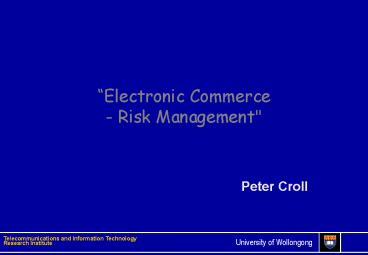Electronic Commerce Risk Management" - PowerPoint PPT Presentation
1 / 26
Title:
Electronic Commerce Risk Management"
Description:
Safety-related large equipment loss, environmental damage, human injury ... Top level management must be involved. Don't be complacent ... – PowerPoint PPT presentation
Number of Views:1808
Avg rating:3.0/5.0
Title: Electronic Commerce Risk Management"
1
Electronic Commerce - Risk Management"
- Peter Croll
2
Why is risk analysis important?
- Large projects ? expensive failures
- Small companies ? loss of business
- Safety-critical ? loss of life
- Safety-related ? large equipment loss,
environmental damage, human injury
3
Risk Identification
- Technology risks
- People risks
- Organisational risks
- Tools risks
- Requirements risks
- Estimation risks
4
Risk Planning
- Avoidance strategies- reducing the probability
of the risk occurring - Minimisation strategies- reducing the impact
- Contingency plans- having an alternative strategy
5
Risk Analysis is core for Software Engineering
Boehms spiral model (simplified)
6
Why analyse risk?
- Building a dependable distributed systems is
difficult - Enterprises have to weigh up the risks of
competing forces
time to market
goodprocess
7
some methods for assessing risk exposure
- Delphi
- Threat Scenarios
- ALARP
8
some methods for assessing risk exposure
- Delphi Method
- Team of expert write down perceived threats
- Threats are unified (approx. 50-100)
- Questionnaire drawn up - each threat rated by -
likelihood - importance - cost (time/money) - Team undertakes a number of revisions until
listed in order of importance by - threat -
probability of occurrence - estimation of losses - Response drawn from final list
- Delphi
- Threat Scenarios
- ALARP
9
some methods for assessing risk exposure
- Threat Scenarios
- Brainstorm on how to cope with failures
- Participants asked the effect of- the required
systems were not functioning for a period- the
required systems were destroyed- information was
read by an unauthorised reader- information was
modified with evidence - Plus questions like- how can the system be
harmed?- what are the potential consequences?-
who or what is the enemy?- what are the
targets?
- Delphi
- Threat Scenarios
- ALARP
10
some methods for assessing risk exposure
- Delphi
- Threat Scenarios
- ALARP
11
Acceptable risk levels?
- Cost less than company turnover / 10?
- Cost less than the predicted insurance payout?
- Probability of loss of life gt 10-3 p.a.?
- Road deaths in NSW ? 1.3 x 10 4
- Commercial Aircraft probability per flight 3
x 10 6 - Who should determine these?
- How do we know they are accurate?
12
Risk Analysis
lt10 very low10-25 low 25-50
moderate50-75 highgt75 very high
- Probability
insignificanttolerable seriouscatastrophic
- Effects
13
Calculating Integrity with Control Systems
14
Case study - EC superannuation payments
- Paying multiple SA funds through a single
interface - Aimed at Small Enterprises
- Clients connect via the Internet
- Links to the Banks payment and clearing network
- Links directly to the Tax Office
15
Example System Architectural Overview
16
E-commerce Adversaries
Trusted Hackers Malicious Hackers Disgruntled
Employees Industrial Spies Terrorist
Special Interest Groups Journalists Real Spies
Criminals
17
Resources
- Client application software
- Account-number access
- Password access
- Documentation of the system
- Eavesdropping tools
- Reverse-engineering tools
- Real-Time monitor tools
18
Consequence
- Public Disclosure
- Financial Loss
- Inconvenience
- Loss of Trust
- Compromise Credit Rating
- Defamation of Character
19
dispelling some cryptography myths
- obscurity does not enhance security.
- it is easy for someone to create an algorithm
that he himself cannot break. - some people obsess about key length a long key
does not equal a strong system. - the problem with bad cryptography is that it
looks just like good cryptography. - the social problems are much harder than the
mathematics.
20
a process for assessing risk
21
Fault Tree Example
Access compromised
A
Server compromised
Client compromised
Comms compromised
B3
B1
B2
Modified server software
Obtained access codes
Account name compromised
Password compromised
C1
C2
C 3
C4
22
Fault Tree for Access Control Compromised
23
Determining the factors that influence Risk
Threat signature. Each category of threat has a
threat signature.
f 1 resources x knowledge -gt threat-capability f
2 desire x expectance -gt threat-intent
Threat-capability and threat-intent are used to
determine threat-level.
f 3 threat-intent x threat-capability -gt
threat-level
Threat-level and threat-frequency are used to
determine threat-exposure
Threat-exposure and consequence are used to
determine Risk.
f 5 threat-exposure x consequence -gt risk
24
RISK for an E-commerce application
25
Dynamic Analysis - Embedding, Integrating and
Adapting
LEO satellites
Telecoms
Extranet
Risk Engine
Wireless application
Intranet
26
What did we learn about Risk Management?
- Security Risk is dynamic
- Learn from others avoid home grown solutions
- Ongoing reviews and monitoring are essential
- Good lines of communications must be established
- Top level management must be involved
- Dont be complacent

